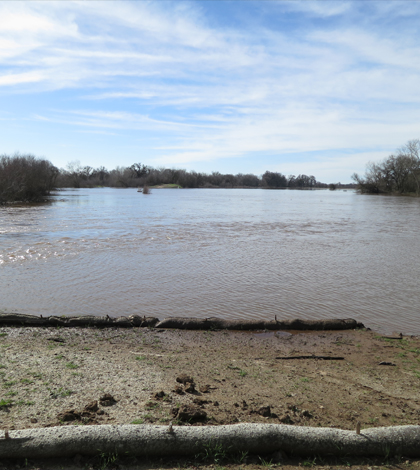Moving levees can help recharge groundwater aquifers in California

A levee along the Cosumnes River. (Credit: Joshua Viers / UC Merced)
Groundwater typically makes up more than 30 percent of California’s annual water usage, according to the state’s Department of Water Resources. But during times like the current prolonged drought, groundwater becomes more important, meeting 46 percent of the state’s annual needs.
With the rising dependence on groundwater in dry times, scientists have begun looking for ways to fill up depleted aquifers and keep flush those still filled with water. The goals have led to new approaches, like one coming out of a research project led by scientists at the Universities of California, Davis and Merced, that looked at structures somewhat overlooked in times of low water levels: flood levees.
The study took place along the Cosumnes River, the last major undammed river in California. It still supports a native salmon run during high water levels, which in turn the investigators hypothesize to provide significant recharge or replenishment of the underlying groundwater system. UC Davis scientists drilled wells in the floodplain and equipped them with pressure transducers to track how moving levees, and hence increased flooding, affects groundwater recharge.
“We were motivated by the water difficulties in California, including those caused by drought and climate warming, which has already caused less snow water storage in recent decades,” said Graham Fogg, professor of hydrogeology at UC Davis. “Both the drought and climate change have resulted in less available surface water, which puts more pressure on groundwater. We want to find out how we can compensate for the loss of surface water storage by recharging groundwater more.”
In addition to more water for humans, there are substantial ecological benefits that can come from moving the levees, and Fogg wanted to investigate those too. For the salmon that need more water to make it to headwaters for spawning, moving levees can be a lifesaver. The benefits the fish receive from extra water tend to ripple up the food chain too.
The ecological payoffs are something officials at The Nature Conservancy, which is funding the ongoing work, want to learn more about. The organization owns the land where the study is taking place and is interested in the benefits of reconnecting the river with its floodplain to support fish.
“In floodplains, fish can grow larger. There are benefits for that, as well as riparian ecosystems,” said Fogg. “Riparian forests also benefit from periodic flooding.”
To measure those benefits, The Nature Conservancy took out sections of levees along the Cosumnes River so scientists could investigate. But the ongoing drought has gotten in the way, providing researchers few opportunities to see water hit the floodplain, says Fogg.
There have only been two events this year when enough water has flown through the Cosumnes for researchers to study effects of it flooding on groundwater.
“Those numbers indicate definitive groundwater recharge benefits and other ecological benefits we’re still studying,” said Fogg. And that really isn’t surprising to him or the rest of the team. “The verifiable measurements help bring attention to this technique as a mechanism for benefitting ecological aspects and also water resources.”
Fogg is conducting similar research on the Sacramento River where he hypothesizes that an engineered floodway and the adjacent groundwater system can be managed differently to enhance subsurface storage of water.
“We want to be able to quantify recharge benefits and to develop a new perspective on water resources management that includes flooding and flood management as a mechanism for improving groundwater quantities,” said Fogg. “Because of our widespread, irrigated agricultural land uses in the Central Valley, groundwater quality is being degraded gradually. If we can introduce cleaner water from flood water, it counteracts the adverse water quality impacts of irrigation.”
Top image: A levee along the Cosumnes River. (Credit: Joshua Viers / UC Merced)





0 comments